Previously: The Devil’s Footprints.
In September of 1931, the Irving family was beset upon by the strangest spook that ever dared rattle its proverbial chains: A creature that became known as Gef the Talking Mongoose. He had other names, too, of course; sometimes his name was spelled “Geoff” or “Jef,” and due to the geographic location in which he appeared — the hamlet of Dalby on the Isle of Man — he was also occasionally referred to as the Dalby Spook. Somehow, though, the phrase “the Dalby Spook” just doesn’t quite capture what made the creature so extraordinary.
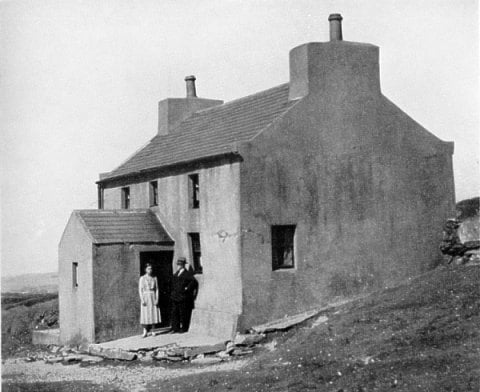
But although it both was then and is now largely believed that Gef’s spirited, cheeky, and sometimes malevolent chatter was the result of ventriloquism and other tricks employed by Voirrey Irving, the family’s 13-year-old daughter, much about the “extra, extra clever mongoose,” as Gef called himself, remains unproven. Voirrey herself maintained for decades that she did not create Gef; what’s more, no satisfactory evidence has ever emerged that states, definitively, exactly what Gef may have been — whether poltergeist, hoax, or collective delusion.
[Like what you read? Check out Dangerous Games To Play In The Dark, available from Chronicle Books now!]
We don’t even really know if Gef was actually a mongoose at all.
The Life And Times Of An Extra, Extra Clever Mongoose
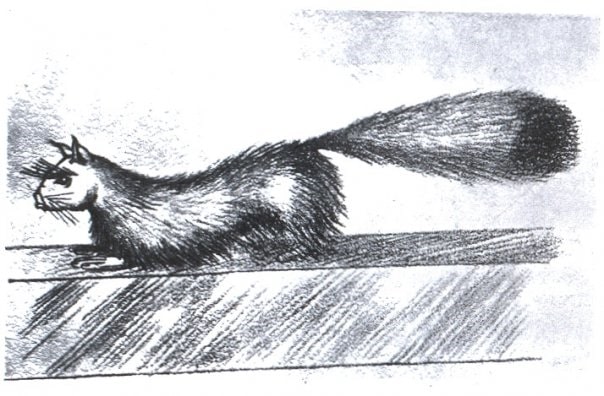
The Irvings lived on a farmstead on top of a hill in Dalby. It was not a successful farm; James “Jim” Irving, an educated man, had previously been a traveling salesman, and although the farm was his retirement project, it was proving insufficient to support his wife, Margaret, and their daughter, Voirrey. (Voirrey was not the Irvings’ only child; however, the two older children, Elsie and Gilbert, were already grown and living on their own in Liverpool and London by the time the move to Dalby and young Voirrey came along.) The place was called Doarlish Cashen — Manx Gaelic for “Cashen’s Gap” — and it was lonely: There were no neighbors nearby; there was on telephone or radio; there wasn’t even electricity.
It began on Sept. 13, 1931. That was when the family began hearing noises coming from inside the walls of their farmhouse. This in and of itself wasn’t exactly odd; then as now, rats and other pests could very easily find their way inside a building and take up residence — and indeed, that’s what the family original thought the noises were: Rats. But traps failed to catch whatever was scrabbling around in the walls, leading Jim to make a last-ditch attempt by growling at the unknown creature.
The creature growled back. And, what’s more, any animal sound Jim made, the creature proved itself capable of mimicking.
Whatever was in the Irving family’s walls, it clearly wasn’t rats.
Also, it could talk.
“It” turned out to be “he”; he said he was called Gef, and that he was a mongoose from India. He claimed he had been born in Delhi in 1852, and had lived, variously, with a “tall man who wore a green turban on his head,” a “hunchback,” and a man by the name of Holland. By the time he took up with Holland, Gef had made his way to Egypt; Holland was the one who took him from there to England.
But much happened before Gef offered forth all this biographical information. Jim and Voirrey had first caught sight of him on Oct. 20, several months before he started talking; according to 1932 article in the Isle of Man Examiner, they described the creature as “possessing a small ratlike body with a long bushy tail, body and tail being of a yellowish hue and the tail speckled with brown.” Voirrey later estimated in an interview some 30 years later that his body was between nine inches and a foot long. By December, what they thought of as the thing in the walls had progressed from animal sounds to those of a baby crying; then, when the Irvings tried reciting nursery rhymes at it, it began to repeat the rhymes back in clear, concise English.
Soon after, he began conversing with the Irvings, whom he credited with teaching him to speak: “For years,” Gef once said, “I understood all that people said, but I could not speak until you taught me.” Even if he hadn’t had the power of speech before, however, he seemed to have picked up rather a lot in his lifetime; he knew bits of a variety of languages, including Russian, Spanish, Welsh, and Flemish. His voice was shrill and squeaky, and he liked to swear. He usually indicated that he was around by calling one of the Irvings by name; he sang along with the gramophone, sometimes putting bawdy twists on his favorites; and when he decided he was done talking, he’d say, “Vanished!” and then disappear.
He had an incredibly high opinion of himself. “I’ll split the atom!” he proclaimed. “I am the fifth dimension! I am the eighth wonder of the world!” He also insisted that he was “not a spirit”; rather, he said, “I am a little extra, extra clever mongoose.” Sometimes, though, he said that he was a spirit: “I am an earthbound spirit,” he said on one occasion, while noting on another, “I am a ghost in the form of a weasel, and I shall haunt you with weird noises and clanking chains.”
Whatever he was, keeping things from him was nigh on impossible due to his extraordinary ears. “Its hearing powers are phenomenal,” Jim wrote in a letter to paranormal investigator Harry Price in 1932. “It detects the whisper from 15 to 20 feet away, tells you that you are whispering, and repeats exactly what one has said.”
Sometimes Gef would leave the house — or at least, he would say that he had been out — and catch rides around town hanging off the backs of cars and other vehicles. He would bring the family the latest gossip; sometimes he’d even kill rabbits and leave them on the doorstep for the Irvings to make for supper. Indeed, he seems to have been something of a gourmet — he loved bacon, sausage, bananas, biscuits, chocolate, and other sweets, which the Irvings would leave for him in saucers on the rafters.
But he was no friendly household spook. He cursed a lot, hurling insults at the Irvings when they did things that displeased him — even if it was just taking too long to open the morning paper (“Read it out, you fat-headed gnome!” cried Gef on that occasion). He threw things — ointment jars, packing-case needles, stones, even heavy pieces of furniture. He threatened the family, saying things like, “I am not evil. I could be if I wanted. You don’t know what damage or harm I could do if I were roused. I could kill you all, but I won’t.”
And he had an unsettling obsession with Voirrey.
He spoke the most to her, and although Jim and Margaret did on occasion glimpse Gef, Voirrey was the only one who was allowed to look at him for any extended amount of time. He frightened her enough that, one night early in his tenure at Doarlish Cashen, she opted to sleep in her parent’s bedroom; she didn’t like being along in the dark while Gef was kicking up such a racket. “I’ll follow her wherever you put her,” Gef spat at the family when they talked about settling Voirrey in Jim and Margaret’s room; then, after the Irvings barricaded the door to ensure that Gef couldn’t get in, the creature double down on his efforts. “Soon we saw the top of the door bulging in as though some terrific force were thrusting against it,” said Jim.
Voirrey gave only one interview as an adult about her family’s alleged experiences with Gef — and although later during his years with the family, he seemed protective of her, she did not remember him fondly. “Gef was very detrimental to my life,” she said. “We were snubbed. The other children used to call me ‘the spook.’ I had to leave the Isle of Man and I hope that no one where I work now ever knows the story.” She even believed that Gef was responsible for her never having married. “How could I ever tell a man’s family about what happened?” she said.
The last thing she ever said on the subject was, “I wish he had let us alone.” She died in 2005.
The Investigations
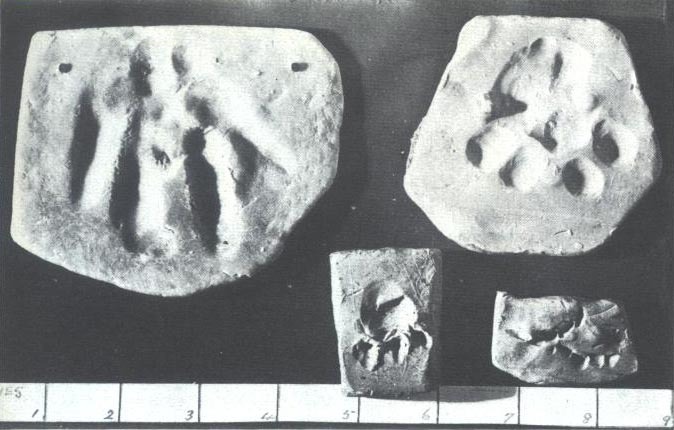
So: What was the public to make of these stories? They were covered in a number of newspapers at the time — but was Gef actually real, or was he just a trick or a hoax? A number of notable investigators undertook to discover exactly what was going on in the Irvings’ farmhouse, and each of them arrived at different conclusions.
“Captain James Macdonald” — actually a pseudonym for Captain James Dennis — visited the farmstead three times between 1932 and 1935 at the behest of Harry Price, to whom Jim had frequently written. Dennis was convinced of Gef’s existence, despite the fact that he never actually saw Gef. He heard him and saw the effects of his movements, though, particularly during a visit in 1935. From a report he wrote Harry Price:
“The voice then started in earnest, and the noise in the house was amazing. Shrill screams, accompanied by terrific knocking, loud bangs, emanated from all parts of the house in quick succession (as if the perpetrator moved with lightning speed)… The noise continued for about 15 minutes culminating with tremendous bangs as if something had been thrown with great violence upstairs.”
He also witnessed a bottle and china tray fly from the top of the staircase while a “derisive laugh” sounded out. Voirrey’s door was still shut tight at the time — so, Dennis believed, there was no way she could be responsible for it.
Price, however, was more skeptical. Although he would eventually visit himself, along with The Listener editor Richard S. Lambert — and, indeed, the duo would later write a book about their findings called The Haunting Of Cashen’s Gap — it took some time for him to get there, during which he continued to receive letters from Jim Irving. Irving sent him some hair samples and casts of footprints allegedly from Gef; however, the hair was determined by Martin Duncan of the Zoological Society not to be mongoose hair. It was probably from a dog. Said Duncan, “I can very definitely say that the specimen hairs never grew upon a mongoose, nor are they those of a rat, rabbit, hare, squirrel, or other rodent… I am inclined to think that these hairs have probably been taken from a longish-haired dog.”
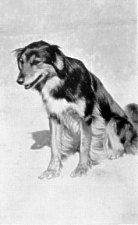
It’s worth noting here that the Irvings had a sheepdog. Her name was Mona.
The footprints, meanwhile, had a huge disparity between the front and back paws; while this matched up with how the Irvings had previously described Gef’s front paws (they were almost human-like, apparently, which is… kind of gross), the Zoological Society again was skeptical. They said that no animal existed with such a disparity between its front and back paws; furthermore, the prints were curiously devoid of the textures one would expect to find on something that had been cast from an actual animal’s skin.
When Price and Lambert visited in 1935, however? Gef was nowhere to be seen. He refused to come out.
After they left, Gef returned and told Jim he’d been away on holiday. For what it’s worth, he had previously expressed a dislike of the very idea of Harry Price, calling him “the man who puts the kybosh on the spirits.”
Price did take some hair samples from the sheepdog Mona while he was there, however, which were later claimed by experts to match the hair that Jim had previously sent him.
Then there was Nandor Fodor, who, like Dennis, believed Gef to be real — and, moreover, to be an actual talking mongoose. Although he, like Price and Lambert, never witnessed Gef, the stories he heard from others were enough to convince him that the Irvings weren’t perpetrating fraud.
Fodor also dismissed the idea of the creature being a poltergeist; he was, Fodor believed, very earthly. “Gef never claims to be without an animal form,” said Fodor. “He eats, drinks, and sleeps… he leaves his teeth marks in the butter in the larder and in the fat of the bacon. He catches rabbits and performs various other services for the family. Poltergeists are an unmitigated affliction. Gef is an asset.”
But although Fodoro initially concluded that “all the evidence is in favor of Gef’s being a talking animal,” he changed his tune later on. In 1952, he wrote that he now believed Gef to still be a talking animal — but also to be a “split-off part” of Jim Irving’s unconscious. Wrote Fodor in Haunted People:
“[Irving] was a man who failed in life and whose many passions were too strong to bear this failure with resignation. As a commercial traveler, originally, his horizons were too wide, both physically and mentally, to reconcile himself to the cabined and confined life of a sheep and goat farmer in a God-forsaken spot where he was constantly struggling against physical starvation.
“The problem of mental starvation, for a man of Irving’s intelligence, must have been even more serious. There was no way to relieve it by conscious means. So his unconscious took care of the job and produced the strange hybrid of Gef, fitting no category of humans, animals or ghosts, yet having common features with all of them. Had Irving been a student of psychical research, the development of Gef would have proceeded, I believe, on more occult lines.”
That is, Gef may have been a manifestation of Jim’s inner psyche.
Or was he?
Who’s The Mastermind?
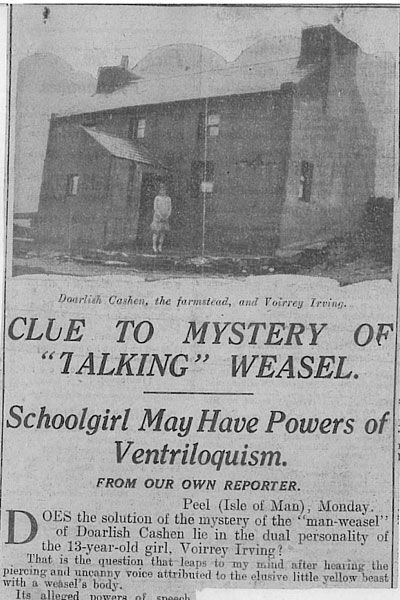
These days, Gef is by and large thought to have been a hoax created by Jim, Margaret, Voirrey, or some combination of the three — although no one is really quite sure who’s actually responsible for it.
In favor of Jim, we have Gef’s preoccupation with Voirrey — read by those who ascribe to this theory as a sort of channeling of his overprotectiveness of his daughter — and the fact that Gef’s activity stopped as he sickened and never resumed after his death.
In favor of Voirrey, we have… a lot, actually. Gef’s likes and dislikes mirror not only those of an adolescent girl in general, but of Voirrey in particular. As Price and Lambert put it following their investigation:
“Gef likes biscuits, cakes and sweets — so do young girls. Gef is interested in motorcars and aeroplanes —so is Voirrey. Gef roams around the countryside, watching parties of workmen and attending various local gatherings consonant with what we know of Voirrey. Gef’s humour, Gef’s wisecracks, Gef’s tantrums, Gef’s affections — all have the quality of raw adolescence.”
Additionally, as the Rational Wiki notes, some evidence suggests that Voirrey — who, like Gef, was quite good at hunting rabbits — began speaking about having a sentient mongoose for a friend who killed the rabbits she brought home some time before either of the adult Irvings took up with the tale. It’s also possible that Voirrey was inspired by the Rudyard Kipling short story “Rikki-Tikki-Tavi,” which features a talking mongoose being adopted by a British family living in India.
Also: Voirrey was lonely. She was isolated. She was bored.
With Gef around, nobody was bored.
Of course, as Nandor Fodor pointed out, the same was true of Jim, so perhaps that’s a motivator for the entire Irving family.
There’s also the idea that Voirrey and Margaret may have been working in tandem, with the unwitting Jim being taken along for a ride. Gef’s love of Margaret is often cited as an indication of this theory being correct; however, other accounts state that the mongoose actually had an intense dislike of her (he bit her on more than one occasion), so I’m not sure how much we can rely on Gef’s relationship with Margaret as evidence about who created him at all.
What also remains a mystery is, if Gef was a hoax, exactly why the Irvings may have created him. The most obvious answer — money — appears to be incorrect; Harry Price noted that Jim refused to sell the few photos the family had snapped of Gef to any newspapers, and had also turned down a theatrical agent’s offer of $50,000 for the rights to Gef and his story. Nor did Price believe it was for fame: “I know two men who, quite recently, have significant their intention of visiting the place, and Irving will not have them,” wrote Price in a letter to a reader.
But, again: Maybe one of them was bored.
Maybe all of them were bored.
Maybe, as Bee Wilson suggested at the London Review of Books, Gef was “the product of three minds working more or less together.”
Maybe it doesn’t matter whether they were doing it consciously or unconsciously.
The fact remains that we still don’t know how it was all done — and we probably never will.
The End Of All Things
Of course, all things must come to an end, and Gef, it turned out, was not immortal. He gradually began appearing less and less, until finally, said Voirrey in 1970, he simply never returned. The last time recalled his presence was in the late 1930s — and just a few years after that, Jim Irving died. Margaret and Voirrey sold Doarlish Cashen and left in 1945. Gef did not follow them.
In 1947, the farm’s new owner, Leslie Graham, claimed to have caught Gef and clubbed him to death with a stick. Voirrey, however, maintained that whatever it was that Graham had displayed as proof, it wasn’t Gef; it was too big. Graham also reportedly never heard the creature talk.
Doarlish Cashen was eventually demolished.
Gef — whether he was real or not — can never go home again.
Recommended resources:
Confessions Of A Ghost Hunter.
Gef The Talking Mongoose in the Fortean Times.
Uncanny Images From An Investigation Into Gef.
Psychic Pets And Pet Psychics.
Gef The Talking Mongoose, 30 Years Later.
Gef: The Eighth Wonder Of The World.
Isle Of Man’s Talking Mongoose.
Gef! The Strange Tale Of An Extra-Special Talking Mongoose.
***
Follow The Ghost In My Machine on Twitter @GhostMachine13 and on Facebook @TheGhostInMyMachine. And don’t forget to check out Dangerous Games To Play In The Dark, available now from Chronicle Books!
This is my favorite legend. Whether Gef is real or not, it’s still fun hearing about a talking mongoose terrorizing a family.
Lemon Demon made a song about Gef callef The Eighth Wonder. You should check it out!!
Thanks for the recommendation!
This really is fascinating, a lot of spooky things go on in the isle of
man, though whether this was real or not is really unclear the evidence is still interesting. This was really well written!
This website is AMAZING! Thanks so much for this wonderful site!
I loved this post, Lucia. Creepy, but cool. Thank you so much for these amazing posts! Next time for the games, can you do the original Oujia board game (also known as the Compass Game)? I did find a video on it by ImJayStation, and it would definitely qualify as a most dangerous game. Plz respond!
Thanks so much for the kind words! Which games appear on the site are in part determined by Patreon supporters as a perk for the $10 tier (check out the Support page for a link through to TGIMM’s Patreon campaign) – I put up a poll on my patrons-only with three options each time it’s time to start planning for another game, and the winning option gets posted. Incidentally, though, I had actually already included The Compass Game in the poll that’s running right now prior to you leaving your comment, so it’s currently in the mix for the next post. If it doesn’t win this time, though, I’ll probably include it as an option again in another poll later on down the line, so we’ll probably cover it at some point!